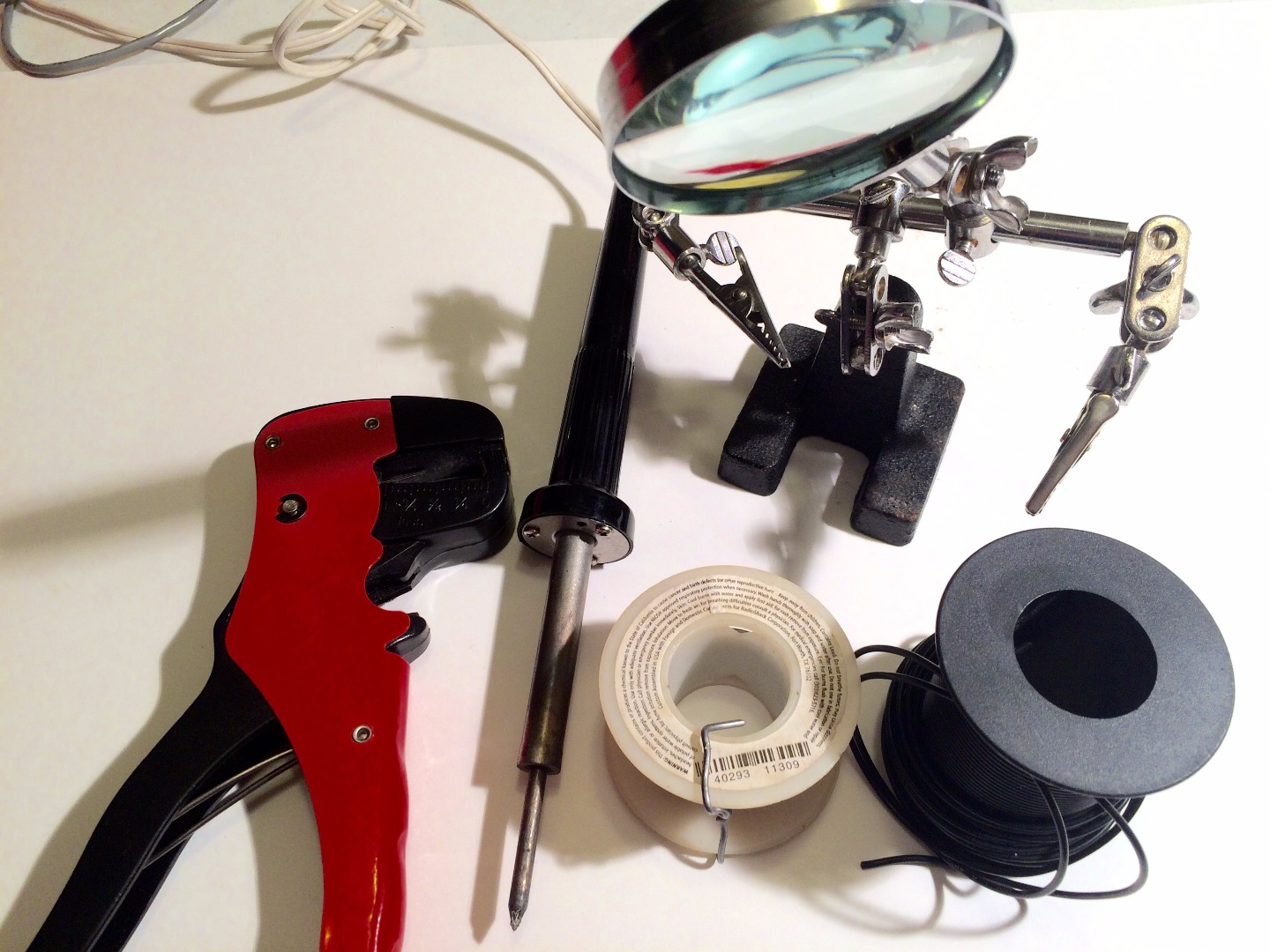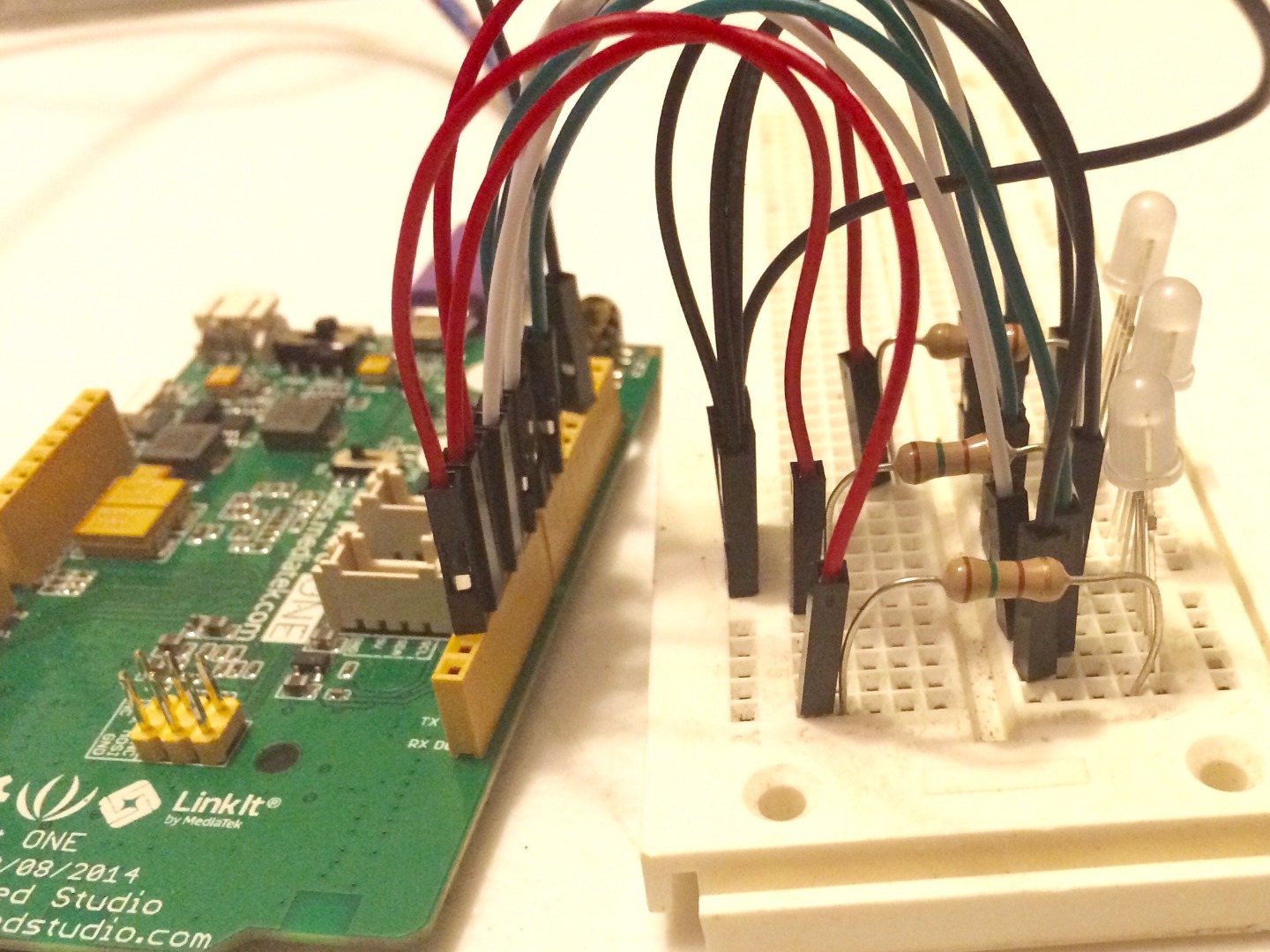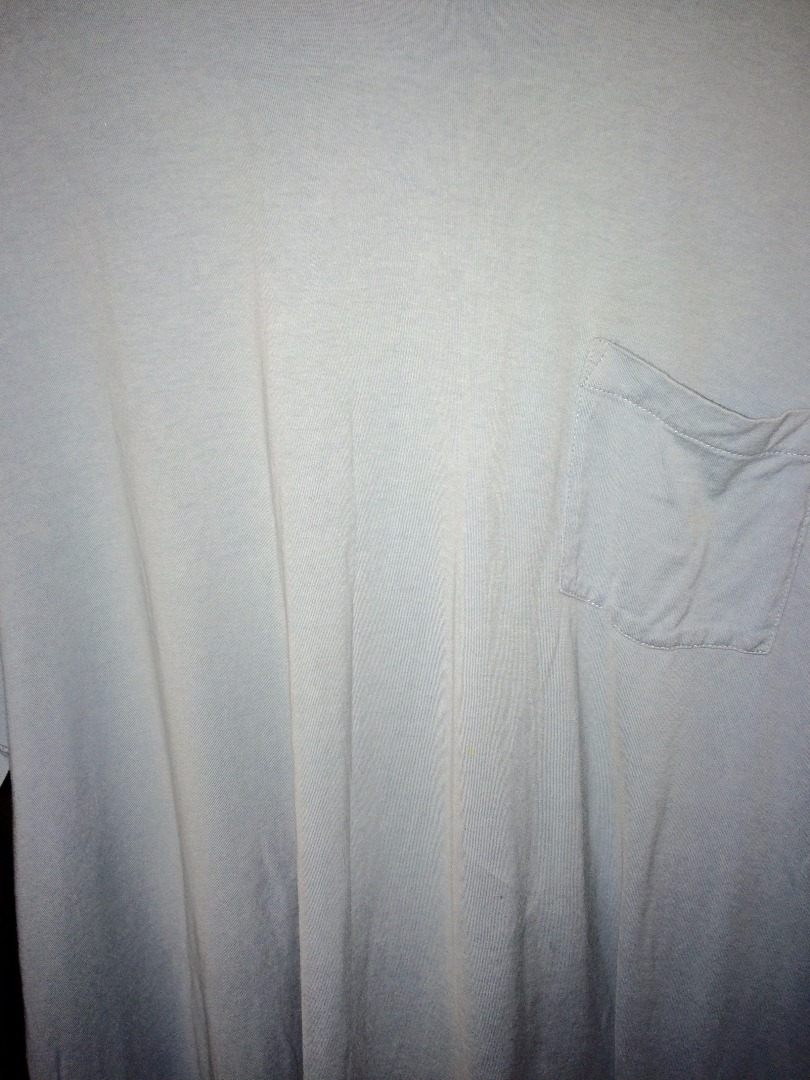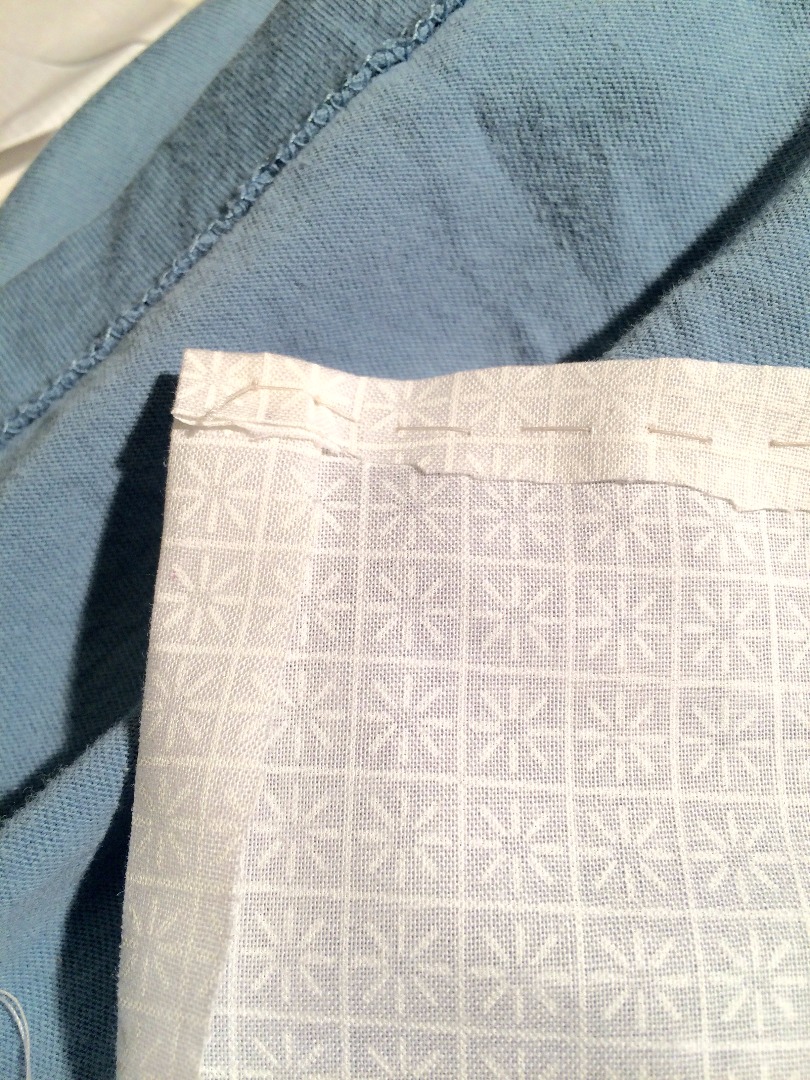Emotion Shirt Using a Linkit One
by ehudwill in Circuits > LEDs
1602 Views, 10 Favorites, 0 Comments
Emotion Shirt Using a Linkit One

My family loves the movie Inside Out. So I thought it would be great if I made a shirt that would show emotions. I decided the Linkit One would be perfect for this as it would give you wireless access to the controls
Tools/Materials





Tools
- Computer
- USB cable
- Soldering Iron
- Wire Cutters
- Needle
- Scissors
- Wire Strippers
- Helping Hands
Materials
- Linkit One
- Battery for Linkit One
- Wifi Cable for Linkit One
- 3 - RGB LED (common anode)
- 1 - Circular Circuit Board
- 1- Breadboard
- 1- Wires (Most of my wires were scavenged from old computers)
- Solder
- 1- Shirt
- Thread
- Extra Fabric
- Super Glue
- 1 - Half a small plastic sphere about the size of the circular circuit board (I got mine from a quarter machine)
- Poly-fil
- Two Part Putty Epoxy (Water Weld)
Code

This code is designed to light up certain colors of the RGB LED. It is set up in such a way that you can activate the color that corresponds with the colors of the emotions in Inside Out.
<p>//#include <b64.h><br>#include <httpclient.h>
#include <ltask.h>
#include <lwifi.h>
#include <lwificlient.h>
#include <ldatetime.h>
#define WIFI_AP ""
#define WIFI_PASSWORD ""
#define WIFI_AUTH LWIFI_WPA // choose from LWIFI_OPEN, LWIFI_WPA, or LWIFI_WEP.
#define per 50
#define per1 3
#define DEVICEID "" // Input your deviceId
#define DEVICEKEY "" // Input your deviceKey
#define SITE_URL "api.mediatek.com"</ldatetime.h></lwificlient.h></lwifi.h></ltask.h></httpclient.h></b64.h></p><p>LWiFiClient c;
unsigned int rtc;
unsigned int lrtc;
unsigned int rtc1;
unsigned int lrtc1;
char port[4]={0};
char connection_info[21]={0};
char ip[21]={0};
int portnum;
int val = 0;
String tcpdata = String(DEVICEID) + "," + String(DEVICEKEY) + ",0";
String upload_led;
String tcpcmd_ledJoy_on = "LED_ControlJoy,1";
String tcpcmd_ledJoy_off = "LED_ControlJoy,0";</p><p>String tcpcmd_ledAnger_on = "LED_ControlAnger,1";
String tcpcmd_ledAnger_off = "LED_ControlAnger,0";</p><p>String tcpcmd_ledDisgust_on = "LED_ControlDisgust,1";
String tcpcmd_ledDisgust_off = "LED_ControlDisgust,0";</p><p>String tcpcmd_ledFear_on = "LED_ControlFear,1";
String tcpcmd_ledFear_off = "LED_ControlFear,0";</p><p>String tcpcmd_ledSad_on = "LED_ControlSad,1";
String tcpcmd_ledSad_off = "LED_ControlSad,0";</p><p>LWiFiClient c2;
HttpClient http(c2);</p><p>void setup()
{
LTask.begin();
LWiFi.begin();
Serial.begin(115200);
/*while(!Serial) delay(1000); /* comment out this line when Serial is not present, ie. run this demo without connect to PC */</p><p> Serial.println("Connecting to AP");
while (0 == LWiFi.connect(WIFI_AP, LWiFiLoginInfo(WIFI_AUTH, WIFI_PASSWORD)))
{
delay(1000);
}
Serial.println("calling connection");</p><p> while (!c2.connect(SITE_URL, 80))
{
Serial.println("Re-Connecting to WebSite");
delay(1000);
}
delay(100);</p><p> pinMode(13, OUTPUT);
pinMode(12, OUTPUT);
pinMode(11, OUTPUT);
pinMode(10, OUTPUT);
pinMode(9, OUTPUT);
pinMode(8, OUTPUT);
pinMode(7, OUTPUT);
pinMode(6, OUTPUT);
pinMode(5, OUTPUT);
pinMode(4, OUTPUT);
pinMode(3, OUTPUT);
pinMode(2, OUTPUT);
getconnectInfo();
connectTCP();
}</p><p>void getconnectInfo(){
//calling RESTful API to get TCP socket connection
c2.print("GET /mcs/v2/devices/");
c2.print(DEVICEID);
c2.println("/connections.csv HTTP/1.1");
c2.print("Host: ");
c2.println(SITE_URL);
c2.print("deviceKey: ");
c2.println(DEVICEKEY);
c2.println("Connection: close");
c2.println();
delay(500);</p><p> int errorcount = 0;
while (!c2.available())
{
Serial.println("waiting HTTP response: ");
Serial.println(errorcount);
errorcount += 1;
if (errorcount > 10) {
c2.stop();
return;
}
delay(100);
}
int err = http.skipResponseHeaders();</p><p> int bodyLen = http.contentLength();
Serial.print("Content length is: ");
Serial.println(bodyLen);
Serial.println();
char c;
int ipcount = 0;
int count = 0;
int separater = 0;
while (c2)
{
int v = c2.read();
if (v != -1)
{
c = v;
Serial.print(c);
connection_info[ipcount]=c;
if(c==',')
separater=ipcount;
ipcount++;
}
else
{
Serial.println("no more content, disconnect");
c2.stop();</p><p> }
}
Serial.print("The connection info: ");
Serial.println(connection_info);
int i;
for(i=0;i<separater;i++) ="" {="" ip[i]="connection_info[i];" }="" int="" j="0;" separater++;="" for(i="separater;i<21" &&="" j<5;i++)="" port[j]="connection_info[i];" j++;="" serial.println("the="" tcp="" socket="" connection="" instructions:");="" serial.print("ip:="" ");="" serial.println(ip);="" serial.print("port:="" serial.println(port);="" portnum="atoi" (port);="" serial.println(portnum);<="" p=""></separater;i++)></p><p>} //getconnectInfo</p><p>void uploadstatus(){
//calling RESTful API to upload datapoint to MCS to report LED status
Serial.println("calling connection");
LWiFiClient c2; </p><p> while (!c2.connect(SITE_URL, 80))
{
Serial.println("Re-Connecting to WebSite");
delay(1000);
}
delay(100);
if(digitalRead(13)==1)
upload_led = "LED_Display,,1";
else
upload_led = "LED_Display,,0";
int thislength = upload_led.length();
HttpClient http(c2);
c2.print("POST /mcs/v2/devices/");
c2.print(DEVICEID);
c2.println("/datapoints.csv HTTP/1.1");
c2.print("Host: ");
c2.println(SITE_URL);
c2.print("deviceKey: ");
c2.println(DEVICEKEY);
c2.print("Content-Length: ");
c2.println(thislength);
c2.println("Content-Type: text/csv");
c2.println("Connection: close");
c2.println();
c2.println(upload_led);
delay(500);</p><p> int errorcount = 0;
while (!c2.available())
{
Serial.print("waiting HTTP response: ");
Serial.println(errorcount);
errorcount += 1;
if (errorcount > 10) {
c2.stop();
return;
}
delay(100);
}
int err = http.skipResponseHeaders();</p><p> int bodyLen = http.contentLength();
Serial.print("Content length is: ");
Serial.println(bodyLen);
Serial.println();
while (c2)
{
int v = c2.read();
if (v != -1)
{
Serial.print(char(v));
}
else
{
Serial.println("no more content, disconnect");
c2.stop();</p><p> }
}
}</p><p>void connectTCP(){
//establish TCP connection with TCP Server with designate IP and Port
c.stop();
Serial.println("Connecting to TCP");
Serial.println(ip);
Serial.println(portnum);
while (0 == c.connect(ip, portnum))
{
Serial.println("Re-Connecting to TCP");
delay(1000);
}
Serial.println("send TCP connect");
c.println(tcpdata);
c.println();
Serial.println("waiting TCP response:");
} //connectTCP</p><p>void heartBeat(){
Serial.println("send TCP heartBeat");
c.println(tcpdata);
c.println();
} //heartBeat</p><p>void loop()
//Red led
{
//Check for TCP socket command from MCS Server
String tcpcmd="";
while (c.available())
{
int v = c.read();
if (v != -1)
{
Serial.print((char)v);
tcpcmd += (char)v;
if (tcpcmd.substring(40).equals(tcpcmd_ledAnger_on)){
digitalWrite(4, HIGH);
digitalWrite(3, HIGH);
digitalWrite(2, HIGH);
Serial.print("Switch LED ON ");
tcpcmd="";
}
else if(tcpcmd.substring(40).equals(tcpcmd_ledAnger_off)){
digitalWrite(4, LOW);
digitalWrite(3, LOW);
digitalWrite(2, LOW);
Serial.print("Switch LED OFF");
tcpcmd="";
}
else if(tcpcmd.substring(40).equals(tcpcmd_ledJoy_on)){
digitalWrite(4, HIGH);
digitalWrite(3, HIGH);
digitalWrite(2, HIGH);
digitalWrite(10, HIGH);
digitalWrite(9, HIGH);
digitalWrite(8, HIGH);
digitalWrite(7, HIGH);
digitalWrite(6, HIGH);
digitalWrite(5, HIGH);
Serial.print("Switch LED ON ");
tcpcmd="";
}
else if(tcpcmd.substring(40).equals(tcpcmd_ledJoy_off)){
digitalWrite(4, LOW);
digitalWrite(3, LOW);
digitalWrite(2, LOW);
digitalWrite(10, LOW);
digitalWrite(9, LOW);
digitalWrite(8, LOW);
digitalWrite(7, LOW);
digitalWrite(6, LOW);
digitalWrite(5, LOW);
Serial.print("Switch LED OFF");
tcpcmd="";
}
else if(tcpcmd.substring(40).equals(tcpcmd_ledDisgust_on)){
digitalWrite(10, HIGH);
digitalWrite(9, HIGH);
digitalWrite(8, HIGH);
Serial.print("Switch LED ON ");
tcpcmd="";
}
else if(tcpcmd.substring(40).equals(tcpcmd_ledDisgust_off)){
digitalWrite(10, LOW);
digitalWrite(9, LOW);
digitalWrite(8, LOW);
Serial.print("Switch LED OFF");
tcpcmd="";
}
else if(tcpcmd.substring(40).equals(tcpcmd_ledFear_on)){
digitalWrite(4, HIGH);
digitalWrite(3, HIGH);
digitalWrite(2, HIGH);
digitalWrite(7, HIGH);
digitalWrite(6, HIGH);
digitalWrite(5, HIGH);
Serial.print("Switch LED ON");
tcpcmd="";
}
else if(tcpcmd.substring(40).equals(tcpcmd_ledFear_off)){
digitalWrite(4, LOW);
digitalWrite(3, LOW);
digitalWrite(2, LOW);
digitalWrite(7, LOW);
digitalWrite(6, LOW);
digitalWrite(5, LOW);
Serial.print("Switch LED OFF");
tcpcmd="";
}</p><p>
else if(tcpcmd.substring(40).equals(tcpcmd_ledSad_on)){
digitalWrite(7, HIGH);
digitalWrite(6, HIGH);
digitalWrite(5, HIGH);
Serial.print("Switch LED ON");
tcpcmd="";
}
else if(tcpcmd.substring(40).equals(tcpcmd_ledSad_off)){
digitalWrite(7, LOW);
digitalWrite(6, LOW);
digitalWrite(5, LOW);
Serial.print("Switch LED OFF");
tcpcmd="";
}
}
}</p><p> LDateTime.getRtc(&rtc);
if ((rtc - lrtc) >= per) {
heartBeat();
lrtc = rtc;
}
//Check for report datapoint status interval
LDateTime.getRtc(&rtc1);
if ((rtc1 - lrtc1) >= per1) {
uploadstatus();
lrtc1 = rtc1;
}
}</p>Downloads
Testing



After working out my code I needed to test it. I set up three LEDs on my breadboard and wired them to the Linkit One. I wired the red leads of the three LEDs into digital pins 2, 3, and 4. I wired the blue leads of the three LEDs into digital pins 5, 6, and 7. I wired the green leads of the three LEDs into digital pins 8, 9, and 10. Then I wired in the ground from the LEDs to the ground of the board.
Making the Light















I bent the ground lead on the RGB LEDs out. I placed the three LEDs in the circle so that the ground leads are near each other. I soldered these three together with the wire for the ground. I trimmed the leads of the LEDs as I soldered wires to them. I soldered the wires to the other leads of the LEDs. I used the left over leads that I cut and soldered them to the other end of the wire to help them fit into the ports of the Linkit One. I used heat shrink tubing to keep the wires together and to protect from shorts. Then I put the wires in the Linkit One in the same pins as I did for the testing step. I used water weld to hold the wires in place. Then I put a small amount of Poly-fil around the LEDs. This helps diffuse the light. Then I put half a small plastic sphere from a cheap plastic toy over the Poly-fil and lights. This gives it a nice rounded look and helps it resemble the memories from the movie Inside Out. I used super glue to hold the plastic onto the lights.
Making the Shirt







I selected a shirt with a pocket to hide the cut I made for the wiring of the light. I cut a small hole behind the fabric of the pocket where the light would fit through. Then I cut a square of fabric that would act as a pocket inside the shirt for the Linkit One. I folded the edges of the fabric over and used a simple stitch to attach it to the bottom of the shirt on the same side as the light.
Putting It All Together

I put the light in the pocket and then connected it to Linkit One. I made sure the battery and wifi antenna were connected. I switched the Linkit One to battery.